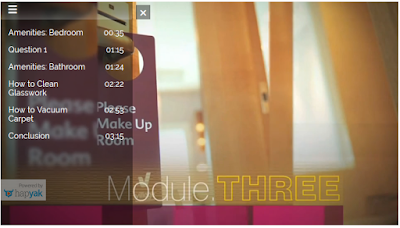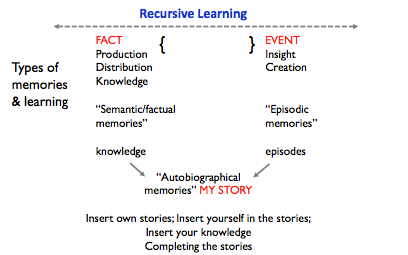We live in a world of so much abundance in terms of videos, whether it be corporate training or personal videos. Video abundance can either make the learners bored - because of too much content, or get them engaged - because it can influence interactivity. When learners are subjected to a very boring and tedious video, they either tend to daydream, not listen or even doze off.
Videos can be found in various references; for personal videos there are big names such as YouTube and Netflix. For learning videos there are TED and Khan Academy as sources.
There are two types of video learners:
- "Watch my video learner." - Learners are putting up and producing their own content. They do it because they want to make sure they have influence on the video while gaining better control, being entertained and learn as well.
- "I'm watching your video learner." - Videos are generally passive, although it can also be used to have interaction.
- Real-life situation + Lecture - this method presents a real-life situation and someone is giving minimal lecture explaining what is happening in the video
- Real-life situation - video depicts real-life situations to reflect on
- Real-life situation video games - this technique is linking a real-life situation to a game thus making it interactive
Image 1 - Click to enlarge image.
Let's take Image 1 above as reference, as we go back to the two types of video learners. Both have elements of entertainment. Just watching videos is passive with no control. When there is more action or control over the learning, this now falls under interacting with videos. The idea of control and passive learning has a lot to do with the types of memories and learning.
Types of memories and learning
Image 2 - Click to enlarge image.
Image 2 above shows and explains the three types of memories and learning:
- Semantic/Factual Memories - Fact
- Episodic Memories - Event
- Autobiographical Memories - My Story
Image 3 - Click to enlarge image.
Content (Fact Only) videos train learners to think of facts alone, thus, not knowing how to use it in real life. Event (Real-life situations) videos serve as good triggers to learner's learning. Real-life situations add value into learning, helping learners to connect to it. Real-life video games are ideal, however, these are costly and not practical for low budget training.
Image 4 - Click to enlarge image.
Increasing interactive sharing stories and experiences
Image 5 - Click to enlarge image.
Videos are one of the many tools used in learning. Some of the other tools are as follows:
- Rating
- Uploading pictures
- Micro-blogging
- Weblogs
- Network
- Chats
- Forums
- Community
- Bookmarking
- Podcast
- Wikis
Image 6 - Click to enlarge image.
If we put the video in the center of the environment just like the image above, it will require interaction from the learners like conversing, applying, testing, documenting and more. By doing that, the video will trigger an action from the learners.
What do learners need to do to make their videos have "My Context", be entertained, have "My Control and learn as well?
#1 In authoring videos, allow learners micro-videos, micro-controls micro-applications.
Play the video and view the text content on the video. Click the question mark (?) each time it appears and see what happens. Ask yourself, how does this technique add to interaction? How can you apply this?
Video #1
With the above video, it shows how learners are allowed to participate and control the video by putting questions or information in context for better experience. The variations of how to use that part is limitless, from questions to poll to procedure to mere information.
#2 Add faster access to transcript for research and references.
Access the video and look for the Transcript. Ask yourself, what is the benefit of a searchable Transcript? How will this add to the interactivity?
Compliments of TED
Video #2
This video shows how TED uses transcripts in their videos. Transcripts allow learners to have quick access and references to the video in detail. It increases the chances for content to be found. Having transcripts also make re-purposing of content easier, for example, if the video or content needs to be translated.
#3 Allow learners to rate, share, comment, revise, edit, add, download, distribute, open, free, etc.
Play the video and see how companies encourage learners to post videos, rate them, bookmark them and pass them around. Ask yourself, hows does it help the learners to see the links and jump to the sections? How does this add to interactivity?
Videos become really viral only because learners are able to distribute them freely. It doesn't need to be professionally done, but the fact that learners can do a lot of things with it such as comment on it, rate it, edit it, share it and many more creates a sense of ownership.
#4 Allow learners to submit project specific videos, eg, troubleshooting, solutions, broken, interviews.
Play the lesson and see Troubleshooting. Look for the list of problems and solutions, and diagnostics. Ask yourself, what would happen if you ask your participants to upload videos on specific problems solutions? How does this add to interactivity?
Video #4
This will enable learners to demonstrate real issues in the field. This will help them to contribute something on the project and it will allow contextualization. There will be some constraints and it will not be useful in other fields such as in IT or environment.
#5 Use videos as part of your gamification efforts.
Play the game. This is an example of a Flash game which can be added to the gamification program that you have. Ask yourself the question: how does it help in interaction?
Video #5
This will allow learners to be part of the video interaction. A video can be a trigger for a challenge. This will permit learners to be part of the video process by asking them to conduct a project using the video as part of the challenge.
#6 Use videos for instant learning on the job.
Play the video and click the top left to see Table of contents. Ask yourself, hows does it help the learners to see the links and jump to the sections? How does this add to interactivity?
Video #6
The video shows how it can be used in the hotel environment as a training component.

The feature added value to the video thus making it more useful. Chapters can also be included or even questions to make learning more interactive. This is a good technology where controls can be added inside the video.
Conclusion
Videos that are proactive, useful and interactive can be used for more effective learning. Combining facts and events to make responsive videos serve as good triggers for learner's learning.
Videos that are proactive, useful and interactive can be used for more effective learning. Combining facts and events to make responsive videos serve as good triggers for learner's learning.
Ray Jimenez, PhD
Vignettes Learning
"Helping Learners Learn Their Way"http://storytakes.com/output/4585/1327/index.html













No comments:
Post a Comment
Welcome! Sharing your comments is very valuable learning experience for me and others. Thanks!